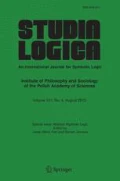Abstract
Combining logics has become a rapidly expanding entreprise that is inspired mainly by concerns about modularity and the wish to join together tailor made logical tools into more powerful but still manageable ones. A natural question is whether it offers anything new over and above existing standard languages.
By analysing a number of applications where combined logics arise, we argue that combined logics are a potentially valuable tool in applied logic, and that endorsements of standard languages often miss the point. Using the history of quantified modal logic as our main example, we also show that the use of combined structures and logics is a recurring theme in the analysis of existing logical systems.
Similar content being viewed by others
References
BARWISE, J., 1985, ‘Model theoretic logics: background and aims’, In J. Barwise and S. Feferman (eds) Model-Theoretic Logics, Springer, New York, 2–23.
VAN BENTHEM, J., 1984, ‘Correspondence theory’, In D. Gabbay and F. Guenthner (eds) Handbook of Philosophical Logic (II), Reidel, Dordrecht, 167–247.
VAN BENTHEM, J., 1993, ‘Beyond accessibility’, In M. de Rijke (ed), Diamonds and Defaults, Kluwer Academic Publishers, Dordrecht, 1–18.
BLACKBURN, P., and C. GARDENT, 1995, ‘A specification language for Lexical Functional Grammars’, Proceedings of the 7th Conference of the European Chapter of the Association of Computational Linguistics, Dublin.
BLACKBURN, P., W. MEYER-VIOL, and M. DE RIJKE, 1996, ‘A proof system for finite trees’, In Proceedings of CSL'95, Springer, New York, 86–105.
BLACKBURN, P., and M. DE RIJKE, 1997, ‘Zooming in, zooming out’, Journal of Logic, Language and Information 6, 5–31.
CARNAP, R., 1947, Meaning and Necessity, The University of Chicago Press, Chicago.
FINE, K., and G. SCHURZ, 1991, ‘Transfer theorems for stratified multi-modal logics’, In Proceedings of the Arthur Prior Memorial Conference, To appear.
FINGER, M., and D. M. GABBAY, 1992, ‘Adding a temporal dimension to a logic system’, Journal of Logic, Language and Information 1, 203–233.
FINGER, M., and D. M. GABBAY, 1996, ‘Combining temporal logic systems’, Notre Dame Journal of Formal Logic 37, 204–232.
GABBAY, D. M., 1981, ‘An irreflexivity lemma with applications to axiomatisations of conditions on linear frames’, In U. Mönnich (ed), Aspects of Philosophical Logic, Reidel, Dordrecht, 67–89.
GABBAY, D. M., 199-, Fibered Semantics, Manuscript, Imperial College.
GARSON, J., 1984, ‘Quantification in modal logic’, In D. Gabbay and F. Guenthner (eds) Handbook of Philosophical Logic (II), Reidel, Dordrecht, 249–307.
GAZDAR, G., E. KLEIN, G. PULLUM, I. SAG, 1985, Generalised Phrase Structure Grammar, Basil Blackwell, Oxford.
GHILARDI, S., 1991, ‘Incompleteness results in Kripke semantics’, Journal of Symbolic Logic 56, 517–538.
GROENENDIJK, J., and M. STOKHOF, 1991, ‘Dynamic predicate logic’, Linguistics and Philosophy, 14, 39–100.
GUREVICH, Y., 1991, ‘Evolving algebras: a tutorial introduction’, Bulletin EATCS 43, 264–284.
HAREL, D., 1984, ‘Dynamic logic’, In D. Gabbay and F. Guenthner (eds) Handbook of Philosophical Logic 2, Reidel, Dordrecht, 497–604.
HEMASPAANDRA, E., 1994, ‘Complexity transfer for modal logic’, Proceedings of the Ninth IEEE Symposium on Logic In Computer Science (LICS'94), 1994.
HEMASPAANDRA, E., 1996, ‘The price of universality’, Notre Dame Journal of Formal Logic 37, 174–203.
KAMP, H., and U. REYLE, 1993, From Discourse to Logic, Kluwer Academic Publishers, Dordrecht.
KAPLAN, R., and J. BRESNAN, 1982, ‘Lexical-functional grammar: a formal system for grammatical representation’, In J. Bresnan (ed), The Mental Representation of Grammatical Relations, MIT Press, Cambridge, 173–281.
KRACHT, M., and F. WOLTER, 1991, ‘Properties of independently axiomatisable bimodal logics’, Journal of Symbolic Logic 56, 1469–1485.
Eiben, G., Á. Kurucz and A. JÁnossy, 1996, Combining logics via combining algebraic theories', Notre Dame Journal of Formal Logic 37, 366–380.
MEYER, R. K., and E. D. MARES, 1994, ‘The semantics of entailment 0’, In K. Došen and P. Schröder-Heister (eds) Substructural Logic, Oxford University Press, 239–258.
MILNER, R., 1989, Communication and Concurrency, Prentice-Hall.
MUSKENS, R., 1996, Meaning and Partiality, Studies in Logic, Language and Information. CSLI Publications, Stanford.
ONO, H., 1983, ‘Model extension theorem and Craig's interpolation theorem for intermediate predicate logics’, Reports on Mathematical Logic 15, 41–58.
POPKORN, S., 1994, First Steps in Modal Logic, Cambridge University Press.
SELIGMAN, J., 1990, Perspectives: a Relativistic Approach to the Theory of Information, PhD Thesis, University of Edinburgh.
SELIGMAN, J., 1996, Combining logics with ease, In preparation.
SHEHTMAN, V., and D. SKVORTSOV, 1990, ‘Semantics of non-classical first-order predicate logics’, In P. Petkov (ed), Mathematical Logic, Plenum Press, New York, 105–116.
SPAAN, E., 1993, Complexity of Modal Logics, PhD Thesis, University of Amsterdam.
THOMASON, R., 1984, ‘Combinations of tense and modality’, In D. Gabbay and F. Guenthner (eds) Handbook of Philosophical Logic (II), Reidel, Dordrecht, 135–165.
VERMEULEN, K., and A. VISSER, 1996, ‘Dynamic bracketing and discourse representation’, Notre Dame Journal of Formal Logic 37, 321–365.
WOLTER, F., 1996, ‘A counterexample in tense logic’, Notre Dame Journal of Formal Logic 37, 167–173.
Author information
Authors and Affiliations
Rights and permissions
About this article
Cite this article
Blackburn, P., de Rijke, M. Why Combine Logics?. Studia Logica 59, 5–27 (1997). https://doi.org/10.1023/A:1004991115882
Issue Date:
DOI: https://doi.org/10.1023/A:1004991115882




